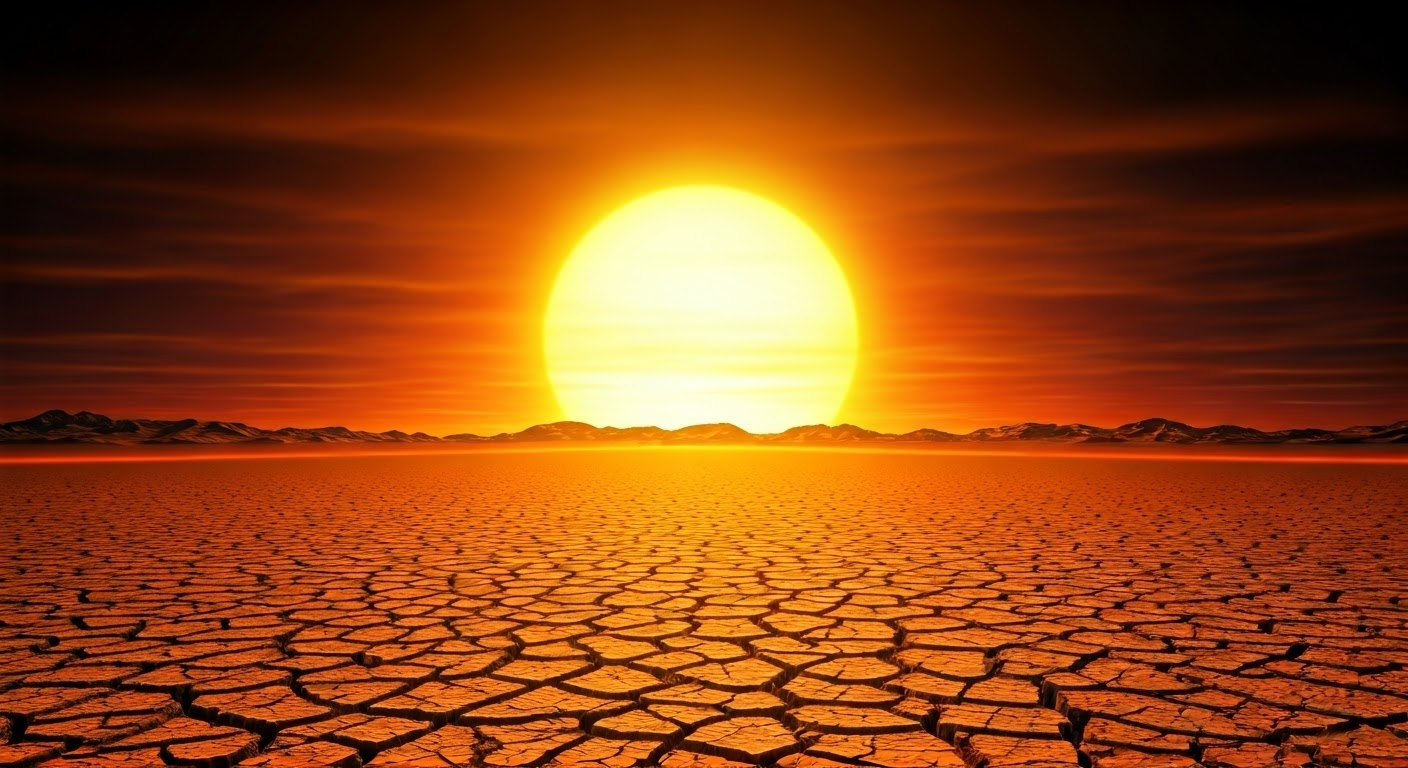Key Highlights
- The climate crisis intensified heatwaves in 2024, adding six weeks of dangerous heat to the average person’s year.
- The Middle East was particularly hard-hit, with Saudi Arabia experiencing 70 additional dangerously hot days.
- This extreme heat poses significant risks to human health, increasing heat-related illnesses and fatalities.
- The agricultural sector and local businesses face economic strain due to extreme temperatures.
- Governments and communities are responding with heat action plans, emergency measures, and public awareness campaigns.
Introduction
The climate crisis is not something far away; it is happening right now. We are seeing its effects in extreme weather events around us. In 2024, we have seen a big rise in weeks of dangerously hot days and dangerous heatwaves everywhere due to global heating. This extreme heat is caused by global warming, and it is affecting people’s lives, the economy, and the environment. As temperatures go up, it is vital to understand what is causing this issue, what it means for us, and how we can fix it.
The Unprecedented Heatwave of 2024: An Overview

The year 2024 has been unusually marked by strong heatwaves that hit many places around the world, constituting a year of extreme weather with an increase of extra days of dangerous heat. These times of extreme heat often break old temperature records and have raised concerns. Scientists from groups like World Weather Attribution (WWA) and Climate Central are studying these heatwaves closely, and their work shows a worrying trend.
They found a strong connection between the climate crisis and the stronger, longer heatwaves we’re seeing. The burning of fossil fuels, which causes global warming, has profound impacts of climate science and fossil fuel warming, filling the air with greenhouse gases. These gases trap heat, leading to rising temperatures around the globe.
Understanding the Severity and Scope
The year 2024 is set to be the hottest year ever recorded, with the world’s hottest day contributing to this alarming trend. This shows a pressing need for action. The effects of this extreme heat are really concerning, especially when we look at daily temperatures. Many areas have had more days where the heat is above safe levels. This creates serious threats to people’s health and wellness.
The seriousness of this situation is worsened by the fact that current data might not show the real-time impact, which could be a very gross underestimate, of the extreme temperatures. Many deaths related to heat are not reported, so we do not see the full effect on humans.
Early warning systems are important for saving lives during extreme events. However, they are not used everywhere in the world. This lack of readiness puts vulnerable groups at higher risk. It shows we need better and fairer plans to adapt to these changes.
The Role of Climate Change in Escalating Temperatures
The link between climate change and stronger heatwaves is clear. Climate change, mostly caused by burning fossil fuels, is making global temperatures rise. This pushes us farther from having a safe climate.
Greenhouse gas emissions from activities like burning coal, oil, and gas trap heat in the atmosphere. This heat acts like a big blanket around the Earth. It causes global warming, and we see its effects in higher temperatures and more extreme weather events.
To tackle this problem, we need to change from fossil fuels to cleaner, renewable energy sources. It’s very important to use energy efficiently and invest in sustainable technologies. This will help reduce the impacts of climate change and slow down the harmful effects of global warming.
The Human Impact: Health and Livelihoods at Risk

The effects of long periods of extreme heat are not only on the environment; they also affect people deeply. More people are getting sick from heat-related problems. Those who are most at risk include the elderly, children, and people with health issues.
Besides health dangers, extreme heat also puts jobs at risk. Farming relies a lot on good weather, and it can suffer from lower harvests and crop failures. This situation puts food security and economic stability in danger.
Heat-Related Illnesses and Fatalities: A Rising Concern
The severe suffering from extreme heat is seen mainly in the increase of heat-related illnesses and deaths. Heatstroke, heat exhaustion, and heart problems become more common. This creates a heavy demand on healthcare systems.
Sadly, many deaths related to heat are not reported. This is especially true in areas that do not have good monitoring systems. The lack of reporting on heat deaths hides the real impact of extreme heat. This makes it hard to truly understand and deal with this growing public health problem.
To fight this crisis, we need to invest in strong health systems. We also need to raise awareness about the dangers of extreme heat. Taking quick action is important too. Clear and complete reporting on heat-related deaths is vital. This will help guide policy choices and focus on public health needs.
Economic Toll on Agriculture and Local Businesses
The effects of fossil fuel warming go beyond just health issues. They also create big economic problems for many areas, especially agriculture and small businesses.
Farming, which is already affected by climate changes, is facing more challenges from extreme heat. This heat leads to fewer crops, stress on animals, and a greater need for water. These problems threaten how much food we can grow and our food safety. This can hurt local economies, especially in areas that depend a lot on farming.
Local businesses feel the impact too. Workers can be less productive, energy use goes up due to cooling needs, and supply chains can get disrupted. All of this leads to economic challenges. To manage these changes effectively, we need new ideas and support from the community. This shows why we need strong climate action that helps with both preventing problems and adjusting to changes.
Government and Community Responses to the Crisis
In response to rising heatwaves, governments and communities all over the world are taking action. They see the urgent need to do something about it. Many are creating plans to reduce the effects of extreme heat and keep their people safe.
They are putting into place heat action plans. They are also setting up cooling centers and informing the public. These efforts aim to strengthen their ability to cope with extreme heat and lessen its harm to people and the economy.
Emergency Measures and Heat Action Plans
Recognizing the escalating threat of extreme heat, many governments are implementing heat action plans, outlining coordinated responses to protect public health during heatwaves. These plans typically involve a multi-agency approach, leveraging resources and expertise to ensure a timely and effective response.
Emergency measures implemented during heatwaves often include opening cooling centers to provide respite from the heat, extending public transportation hours to facilitate safe travel, and conducting outreach programs to vulnerable populations.
| Emergency Measures | Description |
| Cooling Centers | Public spaces such as libraries, community centers, and shopping malls transformed into temporary cooling areas. |
| Extended Public Transportation Hours | Prolonged operation of public transportation systems to reduce exposure to peak heat during commutes. |
| Outreach to Vulnerable Populations | Targeted efforts to reach elderly individuals, those with pre-existing medical conditions, and individuals experiencing homelessness. |
Public Awareness Campaigns and Cooling Centers
Public awareness campaigns are very important. They help people learn about the dangers of extreme heat. These campaigns also help individuals take steps to protect themselves. Organizations like the Red Cross Red Crescent Climate Centre play a big role. They create helpful resources and share key information on how to prepare for and respond to heatwaves.
Cooling centers are lifesavers during extreme heat. They provide a safe, air-conditioned space for people to avoid dangerous temperatures. These centers are usually placed in easy-to-reach areas. They especially help those who may not have good cooling options at home.
It is essential to give people the knowledge and tools to stay safe during heatwaves. This helps to lower the risk of heat-related health problems and deaths. Public awareness campaigns usually share tips for heat safety, remind people to stay hydrated, and highlight how to spot and treat signs of heat stress.
Conclusion
The 2024 heatwave in the Middle East shows that we need to act fast against climate change. Rising temperatures hurt people’s health, jobs, and local economies. It’s very important for governments and communities to take quick steps. They should raise awareness and set up cooling centers to help with the severe heat. People should also do things to stay safe during heatwaves. We need long-term plans and community efforts to deal with the rising number of extreme weather events. If we work together, we can create a better future for everyone.
Frequently Asked Questions
What are the Immediate Health Risks of Extreme Heat?
Extreme heat, pointed out by World Weather Attribution and climate experts like Dr. Friederike Otto, can be very dangerous for health. It can lead to heatstroke and heat exhaustion. It can also worsen heart and lung problems. These issues are especially risky for groups of people that are more vulnerable.
How Can Individuals Protect Themselves from Heatwaves?
Taking action before and during heatwaves is important for your safety. Experts, like Kristina Dahl, say you should drink enough water and look for cooler places, especially when it is very hot outside. Also, pay attention to early warnings about extreme events to help keep yourself healthy.
Are There Long-Term Solutions to Combat Such Extreme Weather?
Addressing the climate crisis is very important. We need to quickly move away from fossil fuels to help reduce extreme weather events and create a more stable place for communities. Senior Lecturer Julie Arrighi points out that the top resolution for addressing this crisis involves focusing on better urban planning, stronger infrastructure, and improved healthcare systems. These are key long-term solutions for managing the effects of extreme weather.
How Does Climate Change Influence the Frequency of Heatwaves?
Climate change caused by global warming is a major reason why heatwaves are happening more often and are getting stronger, contributing to the release of large amounts of carbon dioxide into the atmosphere, pushing the climate towards a drier state. The lead of WWA says that higher temperatures, mostly from greenhouse gas emissions, create better conditions for longer and hotter heat events.
What Actions Can Local Communities Take to Mitigate Heat Risks?
Local communities, including the Pacific Island States, can take steps to lower heat risks. Dr. Friederike Otto points out that having community heat action plans is very important. More green spaces can help with natural cooling. It’s also key to inform residents about heat safety measures.


